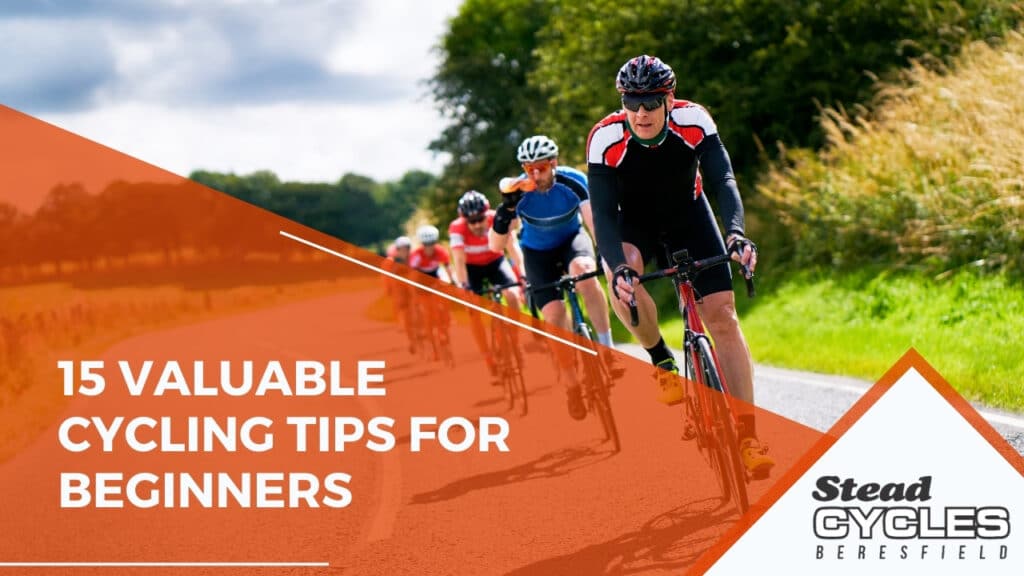15 Valuable Cycling Tips for Beginners

Helpful tips to pedal you into your new hobby
Cycling can bring you a world of benefits. Improved health, boosted mood, improved sense of freedom and more chances to socialise. What better way to get your foot in the door than following these tried and tested tips and tricks? To get you there (and back again), here are a couple of valuable cycling “must-do’s”, specially written for novice bikers and prospective cyclists by the team here at Stead Cycles.
Cycling tips for beginners: Before, during and after the ride
With the tips below, you don’t have to worry about a thing, all you have to do is get out there on that successful ride!

Before the ride
- Pump your tyres correctly.
- Position your saddle correctly.
- Prepare for the weather.
- Bring water and a snack.
- Wear the appropriate cycling gear.
Pump your tyres correctly
Proper tyre pressure helps you ride smoothly. It also enables you to avoid damage and punctures. To check what the right range of pressure for your tyre is, check the sidewall. Make sure that you don’t go over or under this range.
Check your tyre pressure every now and then to see if any adjustments need to be made. Remember to check the condition of the weather and terrain beforehand to pump your tyres accordingly.
Position your saddle correctly
A bike saddle in an awkward position would make your ride uncomfortable. It would also make pedalling way harder than it should be. A saddle set too high can make you strain when pedalling and might cause unnecessary pain and possible injury. On the other hand, seats set too low minimises your pedalling force because of the lack of space.
Also, ensure that you yourself are positioned right. Not having the proper position and posture can cause various types of aching. Don’t fit in the bike – make it fit you.
Prepare for the weather
Aussie weather can change pretty quickly, and a pleasant cycle might end up miserable if you don’t consider the weather. That’s why you should dress appropriately for the weather (or expected weather).
If you layer your clothes right, you can take them off or put them back on as needed. Again, preparation is key here, and it takes a while to get used to. That’s because it can be tricky to dress for something that can change in under a minute, but it is definitely possible.
Bring water and a snack
Bikers use energy when they cycle. They also sweat out a lot of the water in their body. So, bring water (or some electrolyte/sports drink) for hydration. Don’t forget to pack some light snacks too to keep you going. Protein bars, bananas, or maybe something sweet can help you regain some of your lost energy back.
Wear the appropriate cycling gear
Just as you need to be prepared for the weather, you also need to be prepared for the cycling itself. Padded shorts are key if you want extra added comfort during your ride. You don’t need to wear it with underwear. It will cause chafing.
Cycling gloves are another thing you need to have. Riding will cause a lot of friction on the handlebars and your hands. It’s best to keep them protected with padded gloves or mitts. Of course, you also need good socks and shoes. If not, chafing or discomfort might occur.
Most importantly, wear a helmet! No one can be too safe, so it’s best to be sure.

During the ride
- Be mindful of the road.
- Mind other people in the area.
- Pedal at a steady pace.
- Learn how to control your gears.
- Wear your helmet.
Be mindful of the road
When cycling, you have to have good spatial awareness of what is going on around you. It would help if you keep your eyes on the signs as well.
In addition, you have to be mindful to minimise the possibility of accidents happening. Even with precaution, though, you have to be confident on the road. It makes you more visible to drivers who may not see you if you stick too tight to corners.
Mind other people in the area
Never assume that a driver or pedestrian has seen you. It is always better to err on the side of caution. People can move out in front of you at any time so slow down and have a finger over your break lever, just in case.
Pedal at a steady pace
Make sure you aren’t peddling like crazy or erratically, as it can injure you. Instead, it’s best to have a good and steady rhythm. Cycling this way ensures that your cardiovascular system will get a workout. Doing it regularly will increase your endurance, too.
Learn how to control your gears
To be able to pedal with the perfect cadence, you must understand what your bike gears do. You need to be able to deal with your gears because they can help you immensely. This is especially useful during terrain changes.
Different bikes have different amounts of gears, ranging from just one (no gear change levers) on a BMX, up to 21 gears. Bikes with multiple gears will have 2 levers, placed on the handlebars. The left gear lever is for the front cogs and the right lever is for the rea cogs. The larger (lower) the cog, the easier it is to pedal, but the slower you will travel. As a rule, use large low gears when starting off or going uphill.
Wear your helmet
Wear your helmet when riding. If you don’t have one. Visit us at Stead Cycles. It’s better to feel silly wearing a helmet than to suffer a head injury! Besides, we all wear them, nobody is judging you. Please note, do not hang it by your handlebars because your helmet straps might get caught in the wheels, and also make sure it fits properly on the top of your head, not the rear.

After your ride
- Always cool down and stretch.
- Drink some water.
- Clean the dirt off your bike.
- Repair anything that was broken or damaged during the ride.
- Store your bike accordingly.
Always cool down and stretch
All physical activities need a cool-down period after. Cycling is no different. Cooling down after intense physical activity helps your body ease out of physical exertion. It regulates your blood flow and can also help you relax a bit. Stretch out your legs too, in order to reduce the risk of muscle pain in the morning.
Drink some water
Hydration is important. Cycling is a form of exercise that can make you sweat a lot, so you need to rehydrate. Dehydration can have adverse effects such as headaches, muscle cramps, and weakness. Make sure you don’t rehydrate in only one go, spread it out over 10 minutes or so.
Clean the dirt off your bike
When cycling, things are bound to get dirty or muddied up, depending on the terrain. To prevent rusting, damage, or tracking, make it a habit to clean your bike after use.
Repair anything that was broken or damaged during the ride
This is pretty self-explanatory. Don’t ride damage out, even if it seems minor. It can make your bike deteriorate quickly or even get you in accidents. Make sure you know how to fix things or know someplace that does. However, if you have broken a bike part, it’s best to get new ones from a reputable bike shop.
Additionally, it doesn’t hurt to take a pump, repair kit, a small screwdriver and a small wrench in your backpack. Just in case something goes wrong a long way from home.
Store your bike accordingly
Don’t dump your bike on the ground unceremoniously, store it properly to keep your bike in shape. Protect it from the elements, and more importantly, from being stolen. Keep it in the garage or in the porch. Failing this, lock it up outside under some kind of cover.

Visit the Best Bike Store in Beresfield
Aside from these tips, having the right gear makes cycling infinitely more enjoyable, safe and purpose driven. Check out Stead Cycles in Beresfield, New South Wales!
Cycling doesn’t have to be hard. Follow these tips and get the best gear to make your cycling life heaps easier.
If you enjoyed these valuable cycling tips for beginners, then you’d also love our products. Call us on 02 4966 2141or email us at info@steadcyces.com.au for enquiries on how to jumpstart biking as a new hobby.
